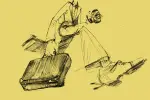The difference between an unpaid and paid internship, typically, is the interview component. In my experience, a 15-minute phone call was enough for the founder of a non-profit and the editor of a magazine to determine whether or not they wanted to hire me.
And then, there’s the highly coveted paid internship, a position that, in many more ways, resembles the structure of a full-time job. Because the stakes for paid internships are higher, recruiting parties typically make applicants jump through more hoops before awarding a position. This, of course, comes in the form of the agonizing interview process.
So, if you’re on the verge of landing your dream job, but first have to ace an interview, you’re going to have to do some prep work. Here are the three steps to take to make sure you’re ready for that big interview.
1. Prepare Notes
Before you even set up an interview, chances are you’re going to have to speak with a talent-acquisition manager whose job it is to screen you and potentially avoid wasting the interviewer’s time.
And though they decide whether or not you move onto the next round, you are at an advantage this time: they can’t see you. So, use the upper hand you’ve been dealt. Keep notes in front of you that reflect the extensive research you did on the organization.
Jot down questions and vital nuggets of information as you hear them. Remember, getting past the screening isn’t the hard part. The interview is.
2. Know Your Enemy (the Interviewer)
Preparing for an interview is basically the equivalent of studying for an exam or verbal reasoning test, because you won’t have a cheat sheet. So, if you didn’t actually know your stuff about the organization before (AKA that extensive research you should’ve done), do it now!
If you can, find out the names of your interviewers. Chances are, they’re on LinkedIn, and this is a fantastic way to think up questions to ask them at the conclusion of each interview. This is non-negotiable.
You might have had an excellent interview, but nine times out of 10, you won’t even be considered for the internship if you don’t ask questions. This is your opportunity to show you truly care about the position you are applying for and that you are passionate about their company. Even if you aren’t, fake it! It will take you far.
3. Find Out What Kind of Interview You’ll Have
There are two types of interviews for internships: video interviews (which are less common) and, of course, in-person, or on-site interviews. The type of interview you receive generally depends on your location.
For instance, as I’m studying abroad but the internships I applied to are in New York, I interviewed via Skype and Zoom. In my opinion, interviews conducted over the internet are not as intimidating as in-person interviews. For one thing, you will never be forced to look into an interviewer’s eyes; your focus will be on the camera in your laptop. You also have the luxury to fidget with your hands without their knowing, too.
As long as you smile and nod appropriately, you will be fine. But whether you are prepping for a video interview or in-person interview, you need to be aware of your facial expressions. Believe it or not, this takes practice. And don’t forget about tone. It not only matters what you say, but how you present it.
A good friend of mine is a math major, and in her internship world, companies request applications as early as January. Having applied and worked for a myriad of government and financial organizations, she knows how to nail an interview. However, at the beginning, she told me that she too was flustered and struggled to perfect her interviewing abilities. It takes time, and, more importantly, patience.
Having applied to a paid internship, I couldn’t rely solely on the phone screening to go well. I had to think big picture, which is why my friend suggested I formulate answers to frequently asked questions. That was step one.
Step two, she said, is practicing, which is not the same as preparing. My friend from Long Island used Photo Booth to rehearse her tone, facial expressions and overall body language. Hopefully, in doing so, her muscle memory would kick in during the actual interview.
I spent two days prior to my first interview staring into the camera lens trying to hone my interviewing skills. While it did raise my confidence a couple notches, every interview, especially depending on the type of company, is different. Sometimes two people will interview you, other times four. I expected to be asked several, if not all of the questions I practiced.
This is not what happened. Instead, the first person to interview me asked only two questions, and then asked if I had any. I was caught off guard, but I had prepared questions to ask. I still had time to kill before my interview with the creative director, so I made up a question on the spot and mentioned the typical stereotypes of English majors as she had been one as well. Jake, the creative director, was interested in how I came across their company. That was it. He then proceeded to talk about the work they do, and finally, asked me if I had any questions.
Although the interview was not what I had envisioned, I thought on my feet and looked into the camera religiously. There is no doubt that both interviews were nerve-wracking, but using Photo Booth beforehand was helpful, and I felt more comfortable than I probably would have otherwise.
My advice is to prepare for the worst, or, in less dramatic terms, try to anticipate what your interviewer(s) could throw at you. Not to mention taking some aptitude tests beforehand. Force yourself to recite your answers aloud, but with feeling; if not, it’s all for naught.
Keep in mind, it is always better to over prepare than under-prepare. Another piece of advice: don’t take yourself out of the running till you know for sure. You never know. Right now, I’m playing the waiting game, but I know I did the best I could do. And that’s what I hold onto.
















